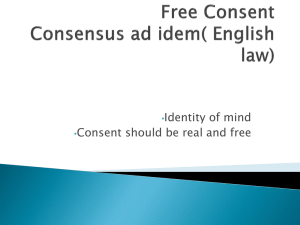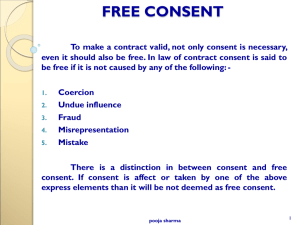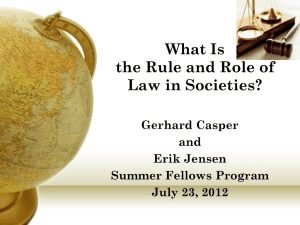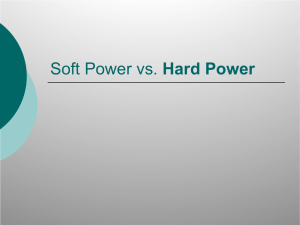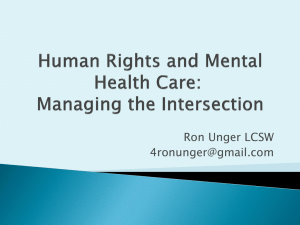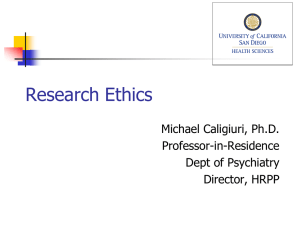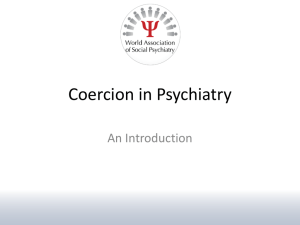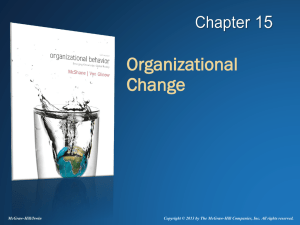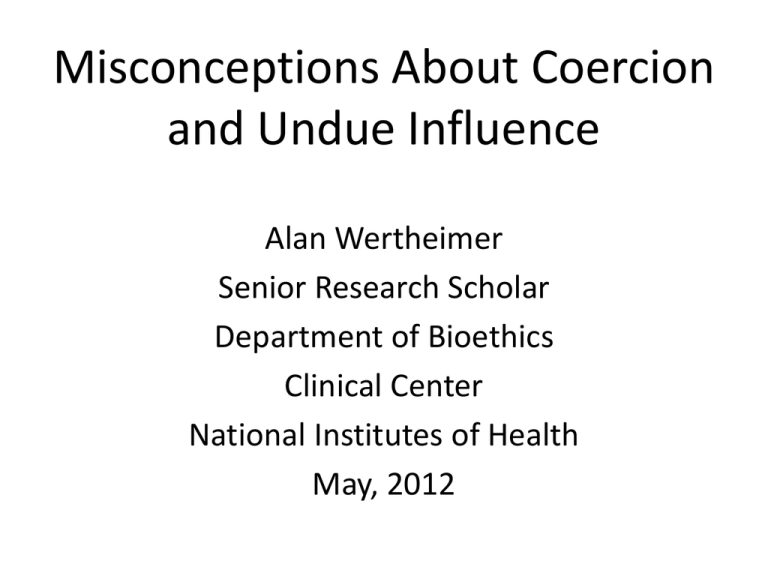
Misconceptions About Coercion
and Undue Influence
Alan Wertheimer
Senior Research Scholar
Department of Bioethics
Clinical Center
National Institutes of Health
May, 2012
Disclaimer
• The views expressed in this talk are my own.
They do not necessarily – in fact they probably
do not – represent the views of the National
Institutes of Health or the Department of
Health and Human Services
Background
• Research participants are commonly offered
payment
• Payment is offered to healthy volunteers and
patient volunteers
• Payment is offered in all kinds of studies
• Wide range of payment amounts ($5-2000),
median $155, (one study of 467 protocols)
Yet . . .
• There remains strikingly divergent views about
the appropriateness of paying research
subjects
Why do we pay research subjects?
•
•
•
•
•
•
Reimbursement
Compensation for time and burdens
Compensation for risk
Avoid exploitation
Incentive for recruitment
Some reasons are more accepted than others
What do we worry about?
•
•
•
•
•
Commodification
Skewed sample
Subject fraud (hiding exclusion conditions)
Coercion
Undue Influence
Coercion or undue influence?
• US Code of Federal Regulations require that
informed consent be obtained “under
circumstances…that minimize the possibility
of coercion or undue influence”
– 21CFR.50
– 45CFR.46
Anecdotal Evidence
• Anecdotal evidence suggests that many IRB
members think that payment or offers of
medical care do or can coerce or constitute
undue influence
• We are inclined to think that these worries are
often based on misconceptions about these
concepts
Two Objectives of Our Study
• Find out what IRB members believe about
coercion and undue influence
• If we find that they believe what we believe
they believe, then we want to show that those
beliefs are based on misconceptions
Background
• What do IRB members and others who are
making decisions about research studies think
about payment, coercion, undue influence?
– How concerned are they about payment?
– What factors are considered when they make
decisions about payment to research subjects?
– How do they understand coercion and undue
influence?
Methods
• Cross-sectional, descriptive, on-line survey
• Random sample of 1800 (+ 269) from PRIM&R
database –individuals involved in human subjects
research
• Advance letter - information about the study, that
participation was voluntary, and responses
anonymous
• $5 in letter
• Email with link to on-line survey
•
Emily A. Largent, Christine Grady, Franklin G. Miller, and Alan Wertheimer, "Money, Coercion, and
Undue Inducement: Attitudes about Payments to Reserach Participants," IRB: Ethics & Human
Research 34, no. 1 (2012): 1-8.
Methods
• Survey pretested -NIH & UVA Center for Survey
Research
• ~ 80 (mostly) multiple choice or Likert questions
• Five domains:
•
•
•
•
•
Level of ethical concern about paying subjects
Reasons to offer money to research participants
Attitudes about coercion and undue influence
Hypothetical scenarios
Demographics
Results: Respondent Characteristics
(n=610)
• 84% Non-Hispanic White
•
• 70% Female ; Average age 51
• 65% masters or doctorate education
• Geographically diverse
• 92% in a job related to human subjects research
• 56% current or past IRB members
Results: Reasons for paying and views about paying healthy and
patient volunteers
% who agree or
strongly agree that it
is acceptable to…
Offer Money
Healthy Volunteer
Patient-subjects with Patient-subjects with
no prospect of benefit a prospect of benefit
86.8%
78.7%
71.1%
Reimburse
for expenses
97.9%
95.4%
92.8%
Compensate for
time, effort,
inconvenience
94.5%
90.7%
86.2%
Offer money as an
incentive
58.3%
56.2%
50.2%
Offer money to
compensate for risk
36.4%
36.9%
34.6%
Results: Respondent views on coercion and undue influence
% of respondents who
agreed or strongly agreed
that if the research
participants …
…are threatened with harm
Then
…it is
coercion
Then
…it is undue
influence
91.2%
-----
…will participate with
payment when otherwise
they would not
…feel they have no
reasonable alternative but
to participate because of
payment
…ability to accurately
perceive risks and benefits
is distorted when offered
payment
64.8%
81.0%
81.6%
79.2%
---
98.2%
Scenario 1
A researcher has developed a new vaccine against malaria. The researcher is
recruiting healthy adult volunteers for a multi-site, Phase I study to determine
if the vaccine is safe in humans.
Sites are US suburb, US inner city, Rwanda
No prospect of direct benefit for the subjects.
Initial visit involves a physical examination, blood draw, and urine test. Six
additional visits over 4 months each expected to last one hour.
Injection of vaccine at first, second, and third visits. At fourth, fifth, and sixth
visits, vital signs will be checked, and blood will be drawn.
Scenario 2
An investigator developed a new drug to treat leukemia. Adult
patients are being recruited for a study of efficacy.
The study is more than minimal risk, but there is a prospect of direct
benefit.
Patient volunteers will be admitted to the hospital for one week and
to receive a dose of the new drug. During hospitalization, additional
research-related procedures not for clinical reasons: PET scan, bone
marrow biopsy, and blood draws.
Every four weeks for 24 weeks, repeat admission and procedures.
Results: Factors considered in determining appropriate payment
amounts
Considered in choosing payment amount
for phase 1 malaria vaccine trial
Considered in choosing
amount for leukemia
treatment study
A US affluent
suburb
67.1
A US
Rwanda
inner city
66.7
65.9
65.7
Compensate for time, effort,
inconvenience
80.1%
82%
78.4%
80.2
Offer money as an incentive
Offer money to compensate for
risk
30.5%
30%
31
31.6
31
31.2
30.5
36.6%
Reimburse for expenses
Questions about the scenarios
Mary, a resident of a US inner city, tells one of the
research nurses: “I would normally not have enrolled in this
[malaria vaccine] study, but I recently lost my job, and I need
the money. I don’t feel like I have any alternative but to
participate.”
1. Do you think Mary has been coerced?
– Yes (24%)
2. Do you think Mary has been unduly influenced?
– Yes (64%)
Questions about scenarios
The leukemia study is approved by an IRB with a
$2,500 incentive payment. John enrolls and tells
the principal investigator: “The bills have piled up
since I got sick, and I feel like my only option is to
participate in this study. I need the money.”
• Do you think John has been coerced?
– Yes (27%)
• Do you think John has been unduly influenced?
– Yes (70%)
Questions about scenarios
Steve enrolls and tells the principal investigator: “I don’t
have health insurance. I don’t care about the money, but
by enrolling in this study, I can get the medical care I
need. I feel like I have no alternative but to participate.”
• Do you think Steve has been coerced?
– Yes (27%)
• Do you think Steve has been unduly influenced?
– Yes (60%)
Conclusions
• Ethical concerns persist among research ethics professionals
about offering payment to research subjects
• Payment as reimbursement or compensation for time and
inconvenience are more acceptable than payment as
incentive or as compensation for risk
• Appears to be a divergence between views about coercion
and undue influence and application to cases
Need for more research
• What decisions do IRBs actually make about
payment?
• Do investigators design payment based on
concerns the IRB might have?
• How do research subjects view payment?
– Does payment affect recruitment?
– What trade-offs do participants make?
– Do people participate in studies they find
objectionable because of money?
From Data to Argument
The Basic Problem
• To the extent that IRB members’ attitudes
regarding payment are ethically sound, they
appropriately influence payment practices
– studies should not be approved if participants’
consent is likely to be compromised by coercion or
undue influence.
• If IRB members’ concerns are based on conceptual or
ethical misconceptions, unnecessary limits may be
placed on payments to research participants and
impede valuable research without ethical cause.
Our Thesis
• Many of the prevalent concerns about payment are largely
misguided.
• Payment never coerces.
• Payment raises ethical concerns with respect to consent
only when it unduly influences participants by distorting
their perception of research risks and benefits.
• In the absence of evidence that such distortions occur, IRBs
should be reluctant to conclude that offers of payment
undermine the validity of consent
Emily A. Largent, Christine Grady, Franklin G. Miller, and Alan Wertheimer, ”Misconceptions about
Coercion and Undue Inducement: Reflections on a Survey of IRB Members, Bioethics
forthcoming.
Coercion
• The Belmont Report: “Coercion occurs when
an overt threat of harm is intentionally
presented by one person to another in order
to obtain compliance.”
• This definition states that coercion requires a
threat of harm
APA: Ethical Principles of Psychologists
and Code of Conduct
• 8.06 Offering Inducements for Research
Participation (a) Psychologists make
reasonable efforts to avoid offering excessive
or inappropriate financial or other
inducements for research participation when
such inducements are likely to coerce
participation.
Coercion
• Most respondents agreed that “Research subjects
are coerced only if they are threatened with harm
if they don’t participate in research” (emphasis
added).
• We suspect that most read the question as asking
whether they thought someone is coerced “if”
rather than “only if” they are threatened with
harm
• Many also agreed with formulations of coercion
that do not involve a threat of harm
Coercion
• Offers of payment do not coerce just because they get
someone to agree to participate in research when they would
otherwise not.
• There are numerous ways of motivating people to do things that
they would otherwise not do
– A persuades B to give blood or go to a movie or invest in a
mutual fund
– A offers the teenager next door $20 to mow his lawn.
– As a general proposition, offers do not coerce.
– Offers can be indecent and immoral but they do not coerce
Coercion
• Some respondents said that people are
coerced to participate in research when they
have no reasonable alternative but to consent
to participate.
Coercion
• No reasonable alternative view is false
• We do not say that a patient who agrees to
surgery or chemotherapy because the only
alternative is death has been coerced to
consent or that her consent to treatment is
involuntary or invalid.
• We do not describe people as coerced if they
take an unpleasant job in order to provide for
their families.
Coercion
• What would constitute coercion to participate in
research?
• If patients have a right that their physicians not
abandon them if they refuse to participate in
research, then the implicit or explicit threat of
abandonment may constitute coercion.
• But such cases involving threats aside, coercion to
participate in research is probably rare.
• Does not apply to offers of payment
Coercion
• We should be concerned when a respondent
says, “Coercion has come to mean something
more along the lines of simple influence in the
IRBs I have worked with - not the meaning it has
in other contexts.”
• Why should the meaning of coercion in IRBs
differ from its meaning in other contexts?
• This respondent’s IRB has adopted an excessively
expansive account of coercion that may be used
inappropriately to limit the activities of
researchers and prospective subjects.
Coercion
• I’m here to reduce your worries
• IRB members and ethicists should simply stop
worrying about the coercive effect of
payment.
• Offers of payment do not coerce. Period.
Undue Influence
• There is nothing problematic about payment
motivating someone to do something they would
otherwise not do
• There is nothing problematic about consent in
exchange for payment when people reasonably
believe they have no other acceptable alternative
• It is not unreasonable to think that the value of
payment exceeds the disvalue of the burdens of
participation
Undue Influence
• The key is reasonable belief
• A’s offer of payment is unduly influential if it is
so attractive that it distorts subjects’
evaluation of the risks and benefits of
participation.
– Myopia
– Tunnel vision
Undue Influence
• The Office for Human Research Protections
(OHRP) guidebook for IRBs says “Offers that
are too attractive may blind prospective
subjects to the risks or impair their ability to
exercise proper judgment.”
Undue Influence
• An offer of payment does not constitute
undue influence if subjects are likely to make a
reasonable or rational choice to regard the
value of the payment as sufficient to justify
the risks or burdens of participation.
• A structural steel worker or lobster fisherman
is not necessarily unduly influenced by the
offer of payment to take on a risky job.
Undue Influence
• There is little evidence that offers of payment
distort judgment and some evidence that they
do not
• Payment may make subjects more attentive to
risk
• Important point is that absent such distortion,
payment does not constitute undue influence
Distinguishing Coercion from Undue
Influence
• Sliding Scale View
• Distinct Concept View
Sliding Scale View
• Undue influence and coercion lie on a
continuum
• Undue influence is a weaker form of coercion
Distinct Concept View
• Coercion compromises the voluntariness of a
decision, but not necessarily its rationality.
– Extortion
• Undue influence compromises the cognitive
dimension of decision-making, but not its
voluntariness.
Caveat
• We do not know the extent to which these
views about payment affect IRB decisionmaking or whether researchers do not
propose payment schedules because they
believe they will be rejected.
Conclusion
• If these views do affect decision-making, then
IRBs inappropriately limit payment offered to
research subjects
– Deprives researchers of opportunity to conduct
research
– Deprives society of benefits of research
– Deprives prospective subjects of opportunities to
participate when they would benefit from doing
so – pseudo-protection
Conclusion
• We should be very reluctant to interfere with
win-win-win activities

